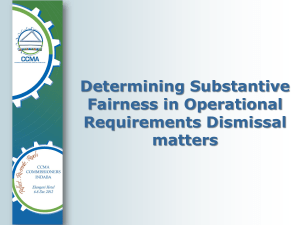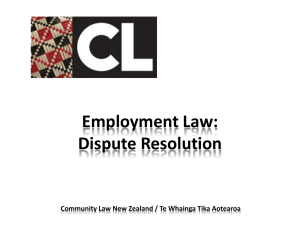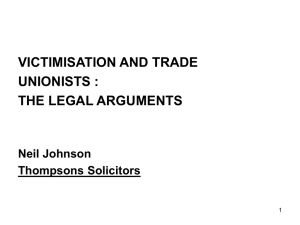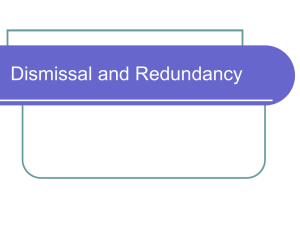work - Your Legal Rights
advertisement
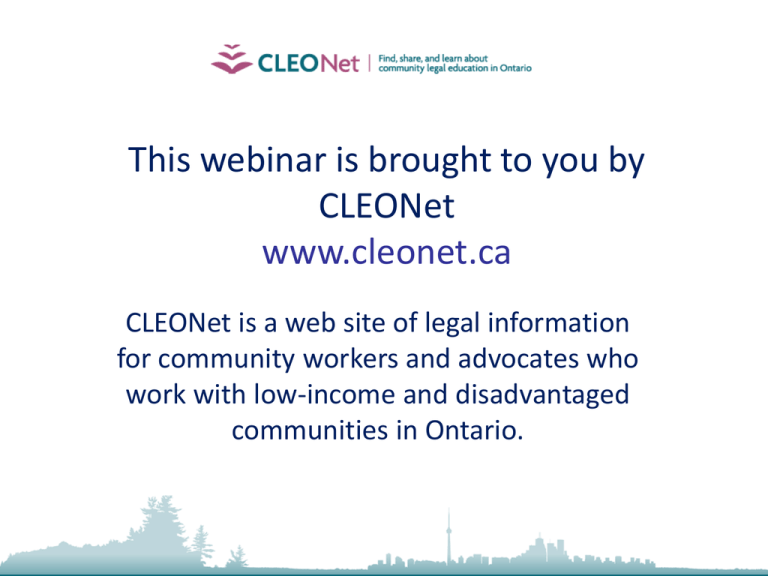
This webinar is brought to you by CLEONet www.cleonet.ca CLEONet is a web site of legal information for community workers and advocates who work with low-income and disadvantaged communities in Ontario. About our presenter… Karen McClellan leads the JUSTICE@work project at the Community Legal Clinic – Simcoe, Haliburton, Kawartha Lakes. As a Staff Lawyer, Karen practices employment and human rights law, with a focus on low-income and vulnerable workers. Her clients include migrant farm workers and live-in caregivers. She has presented on the legal challenges facing workers to community groups, regional clinic training conferences, and provincial and national symposiums. She also served on of the Ontario Bar Association Taskforce on Wrongful Dismissal. Constructive dismissal Harassment, bullying and discrimination at Work March 26, 2010 By Karen McClellan JUSTICE@work Lawyer JUSTICE@ work Presented by JUSTICE@work Is this presentation for you? • You are an Ontario worker who has been fired or feel forced to quit your job OR • Your are an advocate, service provider or ally that a worker or workers may turn to if fired or facing other problems at work JUSTICE@ work Disclaimer This is not a substitute for legal advice. If you need legal assistance, call Legal Aid Ontario at 1-800-668-8258 and ask to be referred to your community legal clinic. JUSTICE@ work Topics Covered 1. What is constructive dismissal 2. What are your legal remedies JUSTICE@ work What is Constructive Dismissal? JUSTICE@ work What is Constructive Dismissal? • Unilateral & fundamental breach of contract • An employment agreement (written or verbal) cannot be changed by the Employer or Employee without agreement by both parties to the change JUSTICE@ work Unilateral Change to Employment Major change in job: Responsibilities, tasks, etc Reduction in pay Change in benefits Demotion Loss of hours Relocation Humiliating and unfair treatment; bullying and harassment JUSTICE@ work Triggering Constructive Dismissal Not every change = constructive dismissal To be considered constructive dismissal, the change must be: NEW Was not contemplated at the time of entering into the contract of employment (written or verbal); MAJOR Results in a major breach of contract and repudiates the contract; NOT ACCEPTED You did not condone or accept the change. JUSTICE@ work Triggering Constructive Dismissal Not every change = constructive dismissal To be considered constructive dismissal, the change must be: NEW Was not contemplated at the time of entering into the contract of employment (written or verbal); MAJOR Results in a major breach of contract and repudiates the contract; NOT ACCEPTED You did not condone or accept the change. JUSTICE@ work Triggering Constructive Dismissal Not every change = constructive dismissal To be considered constructive dismissal, the change must be: NEW Was not contemplated at the time of entering into the contract of employment (written or verbal); MAJOR Results in a major breach of contract and repudiates the contract; NOT ACCEPTED You did not condone or accept the change. JUSTICE@ work Triggering Constructive Dismissal Not every change = constructive dismissal To be considered constructive dismissal, the change must be: NEW Was not contemplated at the time of entering into the contract of employment (written or verbal); MAJOR Results in a major breach of contract and repudiates the contract; NOT ACCEPTED You did not condone or accept the change. JUSTICE@ work Change must be NEW Was this considered when the job began? 1. In contract? 2. Discussed at time of hiring? 3. Common in the industry? 4. Company practice or policy? 5. Duties/hours set or flexible? JUSTICE@ work Change must be NEW Was this considered when the job began? 1. In contract? 2. Discussed at time of hiring? 3. Common in the industry? 4. Company practice or policy? 5. Duties/hours set or flexible? JUSTICE@ work Change must be NEW Was this considered when the job began? 1. In contract? 2. Discussed at time of hiring? 3. Common in the industry? 4. Company practice or policy? 5. Duties/hours set or flexible? JUSTICE@ work OR OR Change must be NEW Was this considered when the job began? 1. In contract? 2. Discussed at time of hiring? 3. Common in the industry? 4. Company practice or policy? 5. Duties/hours set or flexible? JUSTICE@ work OR OR Change must be NEW Was this considered when the job began? 1. In contract? 2. Discussed at time of hiring? 3. Common in the industry? OR OR 4. Company practice or policy? 5. Duties/hours set or flexible? OR Change must be NEW Was this considered when the job began? 1. In contract? 2. Discussed at time of hiring? 3. Common in the industry? OR OR 4. Company practice or policy? 5. Duties/hours set or flexible? OR Change must must be be MAJOR MAJOR Change TEST: A reasonable person would think a key term of employment has been changed Common changes that are major: – – – – – – Reduction in Salary/Pay Demotion Removal of Responsibilities and Core Functions Lay-off Change of Job Duties Change in Benefits (Bonuses, Mat Leave Policy etc) JUSTICE@ work Change must must be be MAJOR MAJOR Change Some changes will NOT result in constructive dismissal Examples: – Removal of secondary duties on a temporary basis – Minor change in duties due to transfer to new location but same position – A very minor change in pay – Company restructuring – Reassignments & Relocation JUSTICE@ work ChangeNOT NOTACCEPTED ACCEPTED Change • Acceptance can be explicit or implicit – Verbal or Written – Actions • You can’t wait too long to decide whether you will accept the change JUSTICE@ work Factors considered by the Court Objective approach based on all the circumstances 1. Was there a significant change to the employment agreement imposed by the Employer? 2. Whether employee accepted the change 3. Whether employer acted in good faith and fairly 4. In some cases: Intent of Employer: Accidental or Intentional Whether legitimate business reasons for the change Factors considered by the Court Objective approach based on all the circumstances 1. Was there a significant change to the employment agreement imposed by the Employer? 2. Whether employee accepted the change 3. Whether employer acted in good faith and fairly 4. In some cases: Intent of Employer: Accidental or Intentional Whether legitimate business reasons for the change Factors considered by the Court Objective approach based on all the circumstances 1. Was there a significant change to the employment agreement imposed by the Employer? 2. Whether employee accepted the change 3. Whether employer acted in good faith and fairly 4. In some cases: Intent of Employer: Accidental or Intentional Whether legitimate business reasons for the change Factors considered by the Court Objective approach based on all the circumstances 1. Was there a significant change to the employment agreement imposed by the Employer? 2. Whether employee accepted the change 3. Whether employer acted in good faith and fairly 4. In some cases: Intent of Employer: Accidental or Intentional Whether legitimate business reasons for the change Factors considered by the Court Objective approach based on all the circumstances 1. Was there a significant change to the employment agreement imposed by the Employer? 2. Whether employee accepted the change 3. Whether employer acted in good faith and fairly 4. In some cases: Intent of Employer: Accidental or Intentional Whether legitimate business reasons for the change Exceptions 1. Worker misconduct IF change is discipline 2. Contract permits change 3. Alternate job is offered JUSTICE@ work Exceptions 1. Worker misconduct IF change is discipline 2. Contract permits change 3. Alternate job is offered JUSTICE@ work Exceptions 1. Worker misconduct IF change is discipline 2. Contract permits change 3. Alternate job is offered JUSTICE@ work Minor Justified or Accepted Changes Situations that are NOT constructive dismissal - Personality conflict at work (minor) - Disputed performance evaluation - Disciplinary actions of employer if warranted and reasonable in circumstances - Slight change in hours, duties etc or a change that you accepted in writing or by continuing to work with changes - Change in work conditions that was foreseeable and could be expected at the time of hiring JUSTICE@ work Humiliating treatment Includes: • Unprofessional and derogatory comments – Includes Human Rights Code grounds (i.e. gender, race, disability, religion, etc) AND other grounds not in the Human Rights Code • • • • Sexual harassment Discrimination Threats Physical violence Humiliating treatment Includes bullying and harassment by: • Boss or supervisor • Co-workers • Third parties (ex. customers of employer) JUSTICE@ work Humiliating treatment Who is responsible? • The employer is obliged to ensure a workplace that is conducive to the well-being of its employees and not hostile. • Workers should take steps to inform management or supervisors of the harassment or bullying so that the Employer has an opportunity to take corrective measures JUSTICE@ work Cannot persevere Humiliating Treatment 1. That undermines employee’s authority/damaging to morale 2. That is abusive, unfair or harassing and is NOT condoned • TEST: Whether the conduct of the employer is such that a reasonable person should not be expected to persevere. JUSTICE@ work Accept, Quit, Work under Protest • A worker must decide within a reasonable time (usually w/in 10 days) to either 1) Accept the change; OR 2) Consider the contract at an end AND either a) Quit OR b) Work under protest (mitigate) Get legal advice before making your decision JUSTICE@ work Accept, Quit, Work under Protest Accept the Change: • If you accept the change, in writing or by your conduct (i.e. continuing to work with changes) then you have condoned the change and there is no constructive dismissal JUSTICE@ work Accept, Quit, Work under Protest Dispute the Change & Quit • An employee will generally not be considered to have failed to mitigate loss of earnings by quitting, in the following circumstances: –Poisoned work environment due to harassment, humiliating and unfair treatment, or human rights discrimination JUSTICE@ work Accept, Quit, Work under Protest Dispute the Change AND Work under protest – to mitigate damages • • • • Get legal advice first Worker may be expected to work in changed job in order to mitigate loss of earnings Request information about changes If you dispute the change but are willing to work under protest in order to mitigate your losses, indicate this clearly and in writing JUSTICE@ work When does the Constructive Dismissal actually take place? 2 Year Limitation Period 2 years to commence an action in court for constructive dismissal The clock starts running • When the Employee resigns; or • When the Employee communicates a refusal to accept the change but works under protest & to mitigate damages Burden of Proof • In a constructive dismissal action, the worker must prove a fundamental breach in the employment agreement occurred • In cases involving humiliating treatment, the employee must prove that a reasonable person would not be expected to persevere in the circumstances JUSTICE@ work Employer obligations under law • Harassment & discrimination free workplace under the Ontario Human Rights Code • Policies and practices in place to ensure a workplace free from violence or threat (OHSA) • Policies and practices in place to ensure a workplace free from harassment and bullying (OHSA) • Termination Pay and/or Severance Pay under ESA if constructive dismissal JUSTICE@ work Worker obligations under law • Treat workers & co-workers with dignity and respect • Respect human rights of employer & coworkers • Comply with company policies on human rights, harassment and civility in the workplace JUSTICE@ work What to do if you are being harassed/bullied? • Seek legal advice • Check employer/company policy manual and follow the steps for making a complaint • If no policy, make a written complaint to your employer – usually direct to Human Resources Dept. – (do not write in the heat of the moment) – sign & date, and keep a copy JUSTICE@ work What to do if you are being harassed/bullied? Legal Options: • Human Rights Application • OHSA – NEW! • ESA: Resign and bring an ESA claim for termination and/or severance pay • Court: Resign and bring an action in court JUSTICE@ work Human Rights Application Human Rights Code (Ontario) – Time Limit: within 1 year of incident/s – You do not have to quit in order to bring a human rights application Canadian Human Rights Act (fed. reg. jobs) – Time Limit: within 1 year of incident/s – You do not have to quit in order to bring a human rights application JUSTICE@ work Occupational Health & Safety Act (OHSA) – Bill 168 • Applies to most Ontario workers - effect June 15, 2010 • Requirements of Employer – Establish policies, practices and provide information on: workplace harassment & violence – Ensure complaint and investigation mechanisms are in place – Ensure worker is working in a safe place pending the completion of an investigation – Ensure measures for immediate assistance in cases of violence – Recognize and protect workers from domestic violence in workplace – Worker can refuse work if worker believes s/he is in danger of workplace violence • Enforced by Ministry of Labour Inspectors – Employees will need to participate in the complaints and investigation process established by employer JUSTICE@ work Employment Standards Act Claim • An employee who is constructively dismissed can bring a claim for termination and/or severance pay under the ESA • Time Limit: file claim within 6 months of dismissal or when pay became owing JUSTICE@ work Questions and discussion JUSTICE@ work This webinar was brought to you by CLEONet For more information visit the Employment and Work section of CLEONet at www.cleonet.ca For more legal information webinars visit: http://www.cleonet.ca/legal_education_webinars

